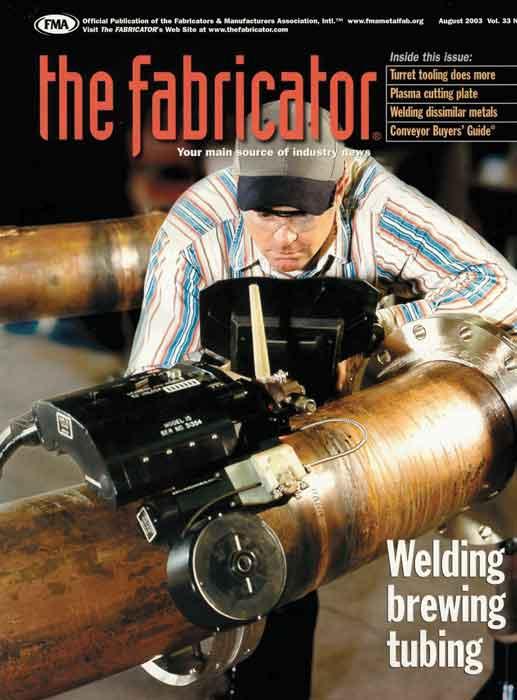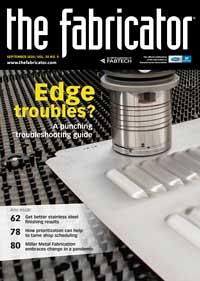Editor-in-Chief
- FMA
- The Fabricator
- FABTECH
- Canadian Metalworking
Categories
- Additive Manufacturing
- Aluminum Welding
- Arc Welding
- Assembly and Joining
- Automation and Robotics
- Bending and Forming
- Consumables
- Cutting and Weld Prep
- Electric Vehicles
- En Español
- Finishing
- Hydroforming
- Laser Cutting
- Laser Welding
- Machining
- Manufacturing Software
- Materials Handling
- Metals/Materials
- Oxyfuel Cutting
- Plasma Cutting
- Power Tools
- Punching and Other Holemaking
- Roll Forming
- Safety
- Sawing
- Shearing
- Shop Management
- Testing and Measuring
- Tube and Pipe Fabrication
- Tube and Pipe Production
- Waterjet Cutting
Industry Directory
Webcasts
Podcasts
FAB 40
Advertise
Subscribe
Account Login
Search
2000s: Tough times take their toll on metal fabricators
Two recessions in the decade force companies to get more serious about the business of metal fabricating, not just making parts
- By Dan Davis
- September 21, 2020
- Article
- Shop Management

Metal fabricators suffered through two recessions in the 2000s, but those shops that survived became better companies. Getty Images
Editor's Note: This is the fourth installment looking at how the modern metal fabrication industry has impacted each decade since 1970, the same era that The FABRICATOR magazine launched. Read about the 1970s, 1980s, 1990s, and 2010s.
When a decade begins with the fear that the world was going to collapse because older computer systems weren’t designed to accommodate the shift over to the year 2000 from 1999, you could argue that unjustified fear was setting the tone for the next 10 years. Looking back, that argument would be hard to refute.
If the 1990s were about metal fabricators taking a step into the world of laser cutting and computer processing, the 2000s were about survival. The dot-com bust, 9/11, the offshoring of manufacturing to China, and the Great Recession put a lot of strain on the U.S. manufacturing base. In fact, many companies that survived the Y2K scare weren’t able to make it through the decade. The reality of customers asking for better terms for reduced volumes of work proved to be a challenge that some shops couldn’t overcome.
Having said that, lessons were learned in the 2000s. Like many in the metal fabricating industry, the survivors of the decade didn’t get a formal degree, but they learned valuable lessons from the experience. The decade positioned them to make the most of what would be the longest economic expansion in U.S. history.
To get an idea of what was happening, let’s take a look back at some of the highlights of the 2000s, as reflected in the pages of The FABRICATOR.
February 2001
The Human Touch
Even as more complex CNC equipment was being introduced to shop floors in the 2000s, people remained the heart of the manufacturing environment. Companies recognized the need for talented and flexible individuals who could float between different fabricating processes.
Begneaud Manufacturing in Lafayette, La., was one such fabricating company (“Company philosophy is based on a novel idea: common sense”). Don Begneaud, the company’s owner, wanted his shop to mimic companies he had visited on vendor-sponsored tours of European metal fabricating companies. He particularly liked the way countries approached apprenticeship programs and hands-on training.
Taking that inspiration, Begneaud developed the position of a “flexo” at his company. The flexo position called for the individual to work wherever they were needed. That meant sweeping, moving material to another station, or helping more experienced equipment operators on a job. During this tenure, the flexo was trained on machines, and when a certain number of hours had been reached, the student graduated to nonsupervised roles.
April 2001
Cutting Gets Complicated
At one time in the life of a metal fabricator, choosing a cutting technology was not that big of a deal. If the company wasn’t punching, it was probably relying on some sort of plasma cutting technology to cut parts for customers. By the 2000s, however, CO2 laser cutting was emerging as a technology that could easily take on 0.50-in. plate.
In “Cutting your losses,” Stephen St. Hilaire of Komatsu’s Cutting Technologies Division provided an overview of where plasma cutting was and how it stacked up against other cutting methods. The comparisons definitely summarized not only where cutting technology was at that time, but where it may have been heading.
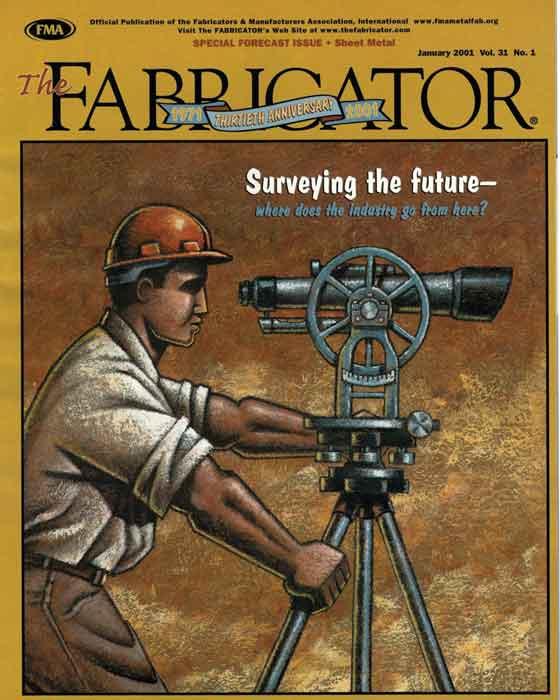
What awaited metal fabricators in 2001 and beyond? A lot of tough economic years, but the experiences made the surviving fab shops stronger for the economic expansion that would happen in the 2010s.
Of course, the feature ended with a solid piece of advice no matter what the era of metal fabricating: “It is recommended that you consult colleagues as well as manufacturers to get information on experiences they have had with these technologies.”
December 2001
Focusing on the Team
At the time U.S.F. Fabrication Inc., Hialeah, Fla., had reduced its lead times from three weeks to three days. It also had not raised customer prices for its products since 1991. How did they do it? Company management pointed to its culture of listening to employees, training, and a commitment to just-in-time manufacturing.
Getting the right people in place helped this effort. “We ask a lot of questions during the multiple interviewing process,” said General Manager David Owens. “We look for trends in the answers and try to weed out those who are more about ‘I’ than ‘we.’”
In addition, all managers and supervisors received eight to 12 hours of leadership training every five weeks. This wasn’t just sitting in a conference room and walking home with a printed-out version of the presentation. Each training workshop included mandatory homework with one-on-one homework reviews the next day.
January 2002
In Search of the Level 5 Press Brake Operator
You’ll recognize Steve Benson’s name from this publication’s Bending Basics column. It’s no wonder that this bending guru was offering his expertise back in the 2000s as well.
In a feature aimed at company management (“Are you getting what you paid for?”), Benson described what a top-of-the-line press brake operator, a “Level 5” as he called it, should be capable of.
“Level 5 is the most skilled level. Operators should have mastered all types of press brakes: up-acting, down-acting, mechanical, and hydraulic, as well as folding machines. They should be able to work on manual press brakes and use all three controller modes: depth, graphic, and angle.
“They should be able to do difficult flat-pattern layouts from customer prints and without the aid of a CAD/CAM system (including notching) and be familiar enough with related equipment to produce the part, whether using a single-station punch, numerically controlled punch, shear, or hardware machine. They should have a working knowledge of geometric tolerancing.
“At this level operators rarely make mistakes, can take a leading role in department operations, and supervise and train lower-level operators.”
Benson estimated that the time line for an operator to reach this level of expertise was seven years.
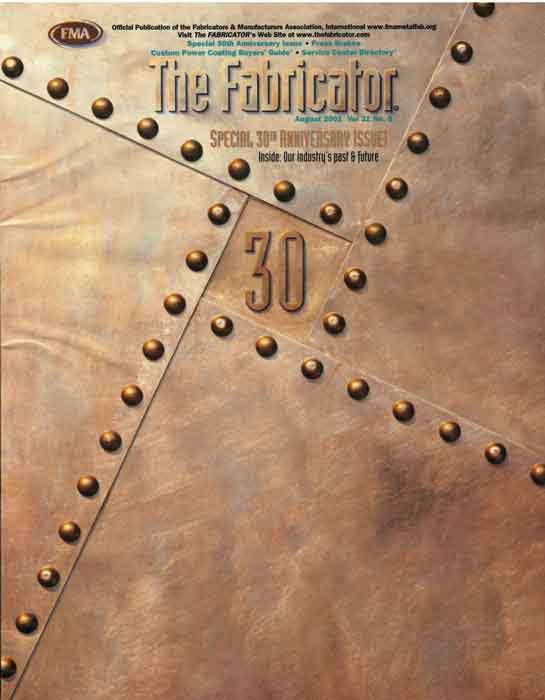
The FABRICATOR celebrated its 30th anniversary in 2001. (Yes, we might have jumped the gun a little bit celebrating the publication’s 50th anniversary in 2020, but we wanted it to coincide with FMA’s 50th anniversary.)
February 2002
The Roller Coaster Ride of a Lifetime
Before Gerald Davis spent his time writing about 3D CAD modeling in The FABRICATOR, he wrote about job shop management. At the time he was president of DSM Manufacturing Co. in Colorado.
In a column called “Emotional thrills” he captured life in a job shop: “When you ride a roller coaster, you know that it is supposed to be fun and will last only a few minutes. The job shop you’re working in isn’t supposed to be anything like a roller coaster ride. Although it should be fun, it had better not have a foreseeable end. Even so, job shops experience many ups and downs. They key is to try to avoid the downs.”
April 2002
The Rise of Manufacturing on Television
The rise of reality television is something that started in the 1980s, but reality manufacturing television really caught on in the early 2000s. “Junkyard Wars” on The Learning Channel (TLC) was one of the first.
By 2002 the show was in its sixth season. (It would last one more before being saved to the digital cloud in the sky.) The premise was simple: Two teams of three had to fabricate something, anything from a race car to a rocket, over a 10-hour period, and the two objects were later judged against field-specific criteria. The teams had access to any tool they might need, as well as an expert in a relevant field who could steer them in the right direction. The junkyard, in which the series was shot, was home to the parts that would ultimately become these Frankenstein fabrications.
The show originally aired in the U.K. under the name “Scraphead Challenge.” The creators of the show actually shared a common desire with many involved in manufacturing in the U.S. According to the series’ website, the point of “Junkyard Wars” was not the competition, but “to teach some science and get kids to think that engineering or something similar can be a fun thing to do with your life.”
May 2002
Steel Tariffs: Sound Familiar?
In late March President George W. Bush enacted tariffs on various imported steel products, ranging from flat products like cold-rolled, plate, and coated sheet steel to circular welded tube products. Imports from the European Union, China, Taiwan, Japan, and South Korea were affected. Mexican and Canadian imports were exempted because of penalties the U.S. would face under the North American Free Trade Agreement.
In the early 2000s the tariffs coincided with a rise in steel prices. Steel-consuming companies were not very pleased.
“The president’s decision made no mention of measures to help steel-using manufacturers waiting for the results of exclusion requests that are not yet resolved,” said Lewis Leibowitz, counsel for the Consuming Industries Trade Action Coalition.
December 2002
Safety First
“20 years without a lost-workday accident” totally works as a headline, but the story also delivered some good tidbits on maintaining safe work environments. The writer interviewed five companies that had earned Safety Awards from the Fabricators & Manufacturers Association (FMA) for five years in a row. Here are some of the tips the writer shared:
- Create a company safety manual, but also include risk prevention tactics.
- Regular walk-around inspections are necessary.
- Create safety programs that reward safety consciousness, such as reporting unsafe working conditions or recommending a new, safer way to do something.
- Get management involvement in committees or leading meetings.
- Keep the shop clean.
“We’re steel workers,” said Sherrill Rogers, safety manager for B. Walter & Co., Wabash, Ind. “Steel is dirty. Steel is sharp. Steel is heavy. Steel is unforgiving. The equipment we use is power equipment. The minute people aren’t paying attention, it’s prime time for an accident.”
February 2003
Productivity Improvements
The 1990s were a decade when fabricating companies adopted laser cutting technology at a rapid pace. The 2000s were a time when fabricators learned that they needed to keep up with the technology.
Hartzell Fan Inc., a custom industrial fan builder, was looking to replace its 8-year-old laser cutting machine at its Piqua, Ohio, plant. It purchased a Gemini 3015 from Amada with a load/unload pallet system, which paid immediate dividends. Not only did the machine take on all of the capacity of the old laser, it also took on work from the company’s plasma cutting table. Company management suggested it was getting about four times more productivity with the new 4-kW laser cutting technology when compared to the older machine.
March 2003
Crawfish? Really?
This issue contained my first editorial as a member of The FABRICATOR staff. I wrote a column about how automated technology might work wonders for the crawfish processing industry, which was seeing real competition from cheaper crawfish imports from China. “Technology and adding value to a product lineup jump out at me as possible cures for intensified global competition,” I wrote.
A reader wrote a letter a few months later just stating: “Crawfish?”

Laser cutting technology became more widely adopted in the 2000s. High-powered CO2 lasers meant that shops could use the machines to cut plate, which used to be the domain of plasma cutting machines.
Maybe he was used to it being called “crayfish.”
July 2003
The Incredible Case of Natural Gas
Has The FABRICATOR ever been more wrong than with the headline “Gas bills unlikely to decrease: Natural gas supply will not increase soon”? That was the thought at least in the early 2000s as industrial companies wrestled with rising energy costs and the inability to raise prices on a fickle customer base.
“Obviously, our electricity costs are influenced by natural gas supplies,” said Jeff Uhlenberg, president of Donovan Heat Treating Co. Inc., at a National Association of Manufacturers press conference. “And because metal treating and a number of other sectors rely so heavily on natural gas as part of our manufacturing processes, we’re being hit with a proverbial ‘double whammy’ as gas supplies become less dependable.”
At the time experts believed that manufacturers and others in the industrial sector used nearly 45% of the natural gas consumed in the U.S. It’s amazing what the emergence of fracking and further development of the natural gas supply chain have done for energy costs in the U.S. It might be one of the most underrated reasons for domestic manufacturing remaining competitive against global competition.
September 2003
Reality Bites for Manufacturing
The recession that began in March 2001 and ended in November 2001 was unlike previous recessions in that U.S. consumers continued to spend money, according to William Strauss and Scott Walster of the Chicago Fed in the article “The disappearance of manufacturing?” Usually during tough economic times, consumer spending, which at the time represented two-thirds of the overall economy, retreats because workers lose jobs and confidence slips.
So if consumer spending remained strong, where did the economic weakness reside during the recession? Strauss and Walster singled out the manufacturing sector as a main area.
“Manufacturing output peaked to June 2000, 10 months before the overall economy went into a recession. The declines continued for 18 months until December 2001, with output declining by 7.6% over this time. In the 15 months since the output trough, manufacturing production has increased an anemic 1.1%. This recent weakness has clearly contributed to cutbacks in employment in the manufacturing sector,” the authors wrote. The trend only reinforced what many know now: U.S. companies are learning to produce more with fewer people.
December 2003
Supporting Manufacturing Education
In an editorial The FABRICATOR announced its support for the FMA’s push to offer scholarships to those interested in engineering, manufacturing technology, and welding.
“We have an interesting dichotomy in the U.S. today,” said then FMA President and CEO Jerry Shankel. “According to government statistics, approximately 90% of the individuals 18 to 24 years old have graduated from high school, yet employers say they cannot find qualified workers. FMA, through its FMA Foundation [now known as the Nuts, Bolts & Thingamajigs Foundation], is trying to help this situation by providing scholarships to individuals interested in entering manufacturing at the engineer or technician level.”
If you are interested in supporting today’s students in pursuing a career in manufacturing, reach out to the NBT Foundation at www.nutsandbolts foundation.org.
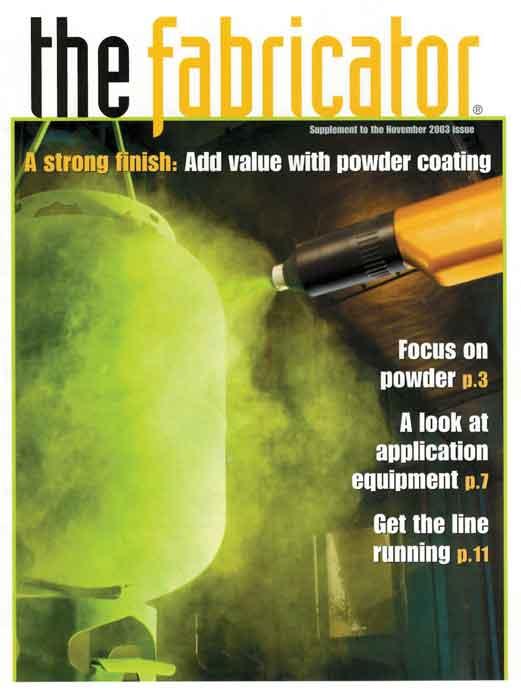
Recognizing the trend of fabricating companies taking on more processes in the metals value chain, The FABRICATOR put together a special section on powder coating in 2003.
Beating the Global Competition
In the late 1990s Steven Southwell, president of Des Plaines, Ill.-based Nu-Way Industries, was told by a multinational customer that his part had to meet the “total cost of acquisition” achieved in China or purchase that same part from a Chinese supplier, inventory it, and incorporate it into the family of parts supplied by Nu-Way. He purchased the parts from China for a time, but soon got back to making them in the U.S. Automation allowed him to do that.
A case study covered how a lineup of Finn-Power (now known as Prima Power) fabricating technologies, including a flexible manufacturing system; a punch/shear combination with unloader, stacking system with buffer storage, and unloading robot; an inline automated bending cell; and a robotic press brake, helped Nu-Way become more productive and reduce the cost associated with making the parts for its multinational customer. Only four people were needed to run the system 24/7.
“This is where you need to be if you’re going to compete against the low-labor-cost countries,” Southwell said. “Because of increased productivity, I can make 10,000 of these parts in 24 hours. What is my revenue for that day compared to my previous output?”
His final piece of advice for other fabricators? “Automate the s**t out of everything you are doing!”
January 2004
Major Metal Fabricating Media Deal
It wasn’t a deal that rocked Wall Street, but it was a major development in the trade journalism business serving the metal fabricating industry. In late 2003 the Society of Manufacturing Engineers’ board of directors authorized the sale of its Forming & Fabricating magazine to FMA. The FABRICATOR became the undisputed No. 1 recognized source of industry coverage after the deal.
The SME and FMA relationship actually dates back to 1979 when both associations founded FABTECH. In the early 2000s the two organizations even worked on other events, such as a hydroforming conference that occurred in 2004.
February 2004
How Lasers Have Changed
In “Cutting through 5 myths about modern lasers,” the author pointed out that it’s a myth that high laser wattage is required to cut at competitive speeds. “In other words, higher wattage does not always equal higher productivity,” he wrote.
That’s pretty amazing considering today’s march toward increased laser strength, but the point was very valid at the time. In most instances, lower-wattage machines then had higher beam quality than higher-wattage lasers. That meant that a 2,000-W laser that generated a high-quality and tightly focused beam could cut a wide range of materials faster than a 3,000-W laser of average beam quality. The laser of reduced power also would have been less expensive and less costly to operate than that 3,000-W laser.
Things have definitely changed since then. The march toward a 20-W laser cutting machine has already begun in 2020.
August 2004
Lean Manufacturing in the Job Shop
Even today some doubt that lean manufacturing can make a difference in a high-mix/low-volume environment. That general feeling was a lot more pervasive in the 2000s when people still associated the phrase with the Toyota Production System and high-volume manufacturers.
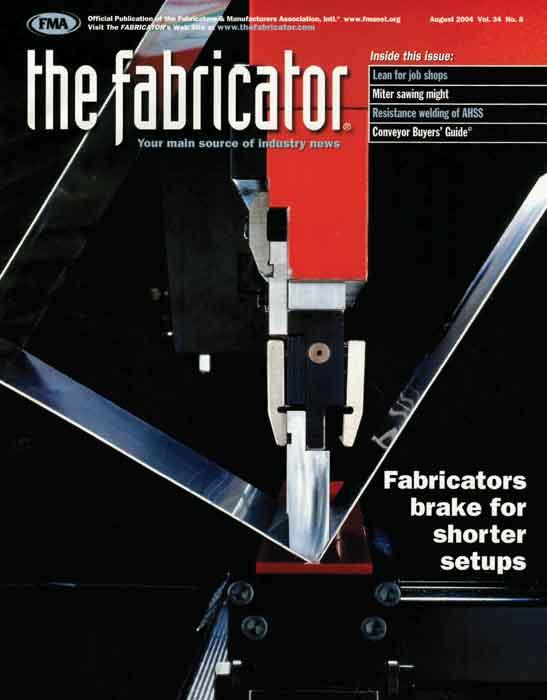
As the pace of fabrication picked up in the 2000s, shops began to look more critically at their setup operations in the bending department.
Some lean manufacturing consultants and fabricators who had implemented successful lean projects shared some advice with readers in the story “Lean on it”:
- Get an outside point of view. A lean manufacturing expert can see opportunities for eliminating waste that someone who works in that same environment likely won’t recognize.
- Invest in training. If employees understand the costs associated with their jobs and rework, they have a better understanding of what can be accomplished by eliminating waste. If those plans also are shown to increase company profit, employees can link lean manufacturing efforts to company prosperity.
- Provide a visualization of what’s to be accomplished. A value stream map details the steps and indicates where value and nonvalue efforts take place. This map charts the course for changes and helps employees to see the dollars that are saved.
- Make a commitment to avoid layoffs. If a company embarks on a lean manufacturing journey, eliminates a job function, and lets go of an employee, that same company isn’t going to get much employee involvement from the remaining staff. Eliminating waste allows for redeployment of human resources elsewhere. That’s the only way to ensure employee buy-in over the long term.
- Consider an investment in technology. It’s not always the answer, but when it makes sense, new fabricating technology usually makes a big impact.
November 2004
FABTECH and AWS Join Forces
For those that don’t remember, the American Welding Society (AWS) used to have its own tradeshow—The Welding Show. In 2004 FMA, SME, and AWS decided to create one supershow.
“From the day I walked into the FMA in 1989, the industry has told me there are too many tradeshows,” Mark Hoper, director of expositions, said. “And throughout the 1990s, the pool of exhibitors and attendees has gotten smaller for all tradeshows.
“We’re trying to add value for exhibitors and attendees because usually they’re able to go to only one event,” he continued. “This will save the welding industry a lot of money.”
For the record, the last SME- and FMA-sponsored FABTECH without AWS was in Cleveland in October 2004. The last AWS Welding Show was in Dallas in April 2005. The first combined event was in Chicago in 2005.

The FABRICATOR profiled BTD Manufacturing, Detroit Lakes, Minn., for the first time in 2006. Twelve years later, the magazine honored the company with its Industry Award. By then it had grown its annual revenues to more than $200 million.
January 2005
The Journey Toward Press Brake Automation Continues
“Assessing the need for an automated press brake system” contained a multitude of bullet points to consider before purchasing a robotic press brake system, but one paragraph really stood out: “Automation may benefit your press brake operation, but unless you are already familiar with automation, it is not likely to be plug-and-play. There is a learning curve, and cultural changes may need to occur.”
More than 15 years later, new automated press brake systems are as close to plug-and-play as they might get, but cultural issues remain. Does a fab shop know its processes well enough to drop in an automated system and have it run as effectively as it should? Technology marches forward, but the human element remains a consistent challenge for most fab shops.
February 2005
Fabricating Technology Advances in Mexico
Even in the 2000s many viewed manufacturing operations in Mexico as simply a cost-savings move. The labor rates were less expensive when compared to the U.S., but delivery was less of a hassle when compared to having something made in China. Not too many companies at the time viewed Mexico as a strategic part of their overall manufacturing operations.
John Deere didn’t see its operations in Mexico that way. Industrias John Deere (IJD), a Deere subsidiary, had spent the previous decade trying to establish a just-in-time manufacturing environment, and it was looking to make a major investment in laser cutting equipment to help push the further transformation of its Mexican operations. After several months of evaluating the technology from different machine tool vendors and checking customer references, IJD purchased TRUMPF’s TCL 4030 CO2 laser, which could cut material as thick as 0.75 in. and as thin as 0.125 in. The machine also had a working range of 162 by 83 by 5 in., which was large enough for the standard sheet size used in Mexico.
The laser cutting machine replaced separate shearing, plasma, oxyfuel, punching, and drilling operations. IJD management said that the laser technology helped it reduce labor and increase material usage, which was then between 80% and 85%. “The final quality of the part is the same, but it is a lot easier to achieve that quality with the laser,” Ignacio Mondragon, an IJD mechanical engineer, said. “Before, to get the same finished part required a lot more operations and created a lot more scrap.”
IJD ultimately purchased eight laser cutting machines for its facilities in Mexico. The company realized that cost-effective manufacturing processes make sense in any metal fabricating facility, no matter where it might be in the world.
July 2005
A Very Big Transition
BTD Manufacturing Inc., Detroit Lakes, Minn., was once Bismarck Tool and Die Co., a simple tool and die shop opened in 1979 in Bismarck, N.D. By 2005 the company had grown to become a contract manufacturer with $68 million in sales and more than 400 employees. “Beyond tool and die” featured one of the largest metal fabricating operations that The FABRICATOR had ever visited.
The company was in the early stages of really looking to crack open new markets with its newfound tube fabricating equipment. It had just spent more than $5 million on tube and bending equipment, such as a BLM 803D laser tube cutting system and two BLM tube benders. In particular the investments helped them to solidify contractual relations with companies in the recreation vehicle market.
Those investments and other company decisions proved to be good ones for BTD. Today it is a regular member of The FABRICATOR’s FAB 40 list with 2019 revenues of $242 million and 1,305 employees.
November 2005
Something You Don’t See Every Day in Waterjet Cutting
Johnson Enterprises Inc., Val D’Amour, N.B., Canada, purchased a Byjet waterjet from Bystronic to fabricate debarking tools for the wood, pulp, and paper mills in Canada and New England. That wasn’t so unusual, but the table’s automated shuttle table was.

As fabricators looked to automation to be more productive, even shops with waterjets considered the use of automated sheet load/unload systems.
While common on a lot of laser cutting machines, the shuttle table, which allowed the machine to be loaded while it was also cutting, on a waterjet was not such a familiar sight. Company owners decided it was the right decision because it felt the table would be much more productive as business expanded. “The option is the most effective way to increase processing time,” Operations Manager Joey Johnson said.
April 2006
A Visit to Jay Leno’s Big Dog Garage
I got the chance to visit Jay Leno’s Big Dog Garage in Burbank, Calif., thanks to some connections with the dealer that supplied the shop with a waterjet equipped with a KMT Streamline SL-V 50 Plus intensifier pump that generated a jet of water to 60,000 PSI. I spoke with Benard Juchli, who ran the garage and worked on most of the cars. He met Leno when Juchli owned a Jaguar repair shop and used to work on Leno’s XK 120.
This kind of summed up the article: “So why does a garage need a waterjet? Because NAPA Auto Parts doesn’t carry gaskets for a 1937 Fiat Topolino.”
July 2006
OSHA Issues New Hexavalent Chromium Standard
In late February the Occupational Safety and Health Administration strengthened its existing standard that limited occupational exposure to hexavalent chromium [CR(VI)]. The new rule significantly reduced the permissible exposure limit (PEL) from 52 to 5 mg of Cr(VI) per cubic meter of air as an eight-hour time-weighted average. OSHA determined that the previous PEL for Cr(VI) posed a significant risk to workers’ health.
Not all were happy with the decision. The original recommendation was to change the exposure limit to 1 mg/m3 of air.
“OSHA’s decision guarantees that many more workers will get lung cancer,” said Michael Wright, the United Steelworkers union’s director of health, safety, and environment.
August 2006
Concern Over Illegal Immigration
The vitriol about illegal immigration into the U.S. from the southern border was one of the main concerns of voters that helped to propel Donald J. Trump into the presidency in 2016. Readers of The FABRICATOR have been concerned about this for quite a while.
“A fence alone will not work,” wrote Teresa Aschenbrenner of Temecula, Calif., in a letter featured in the magazine’s Readers’ Forum section. “If we want illegal immigrants to stop coming, we have to take away the incentive to do so. Employers who hire illegal immigrants should be fined as the current laws state. People who are in the U.S. illegally should not have access to services that U.S. taxpayers pay for.
“If we continue to allow this invasion, the U.S., as we know it, will change socially, economically, and politically—and not for the better.”
April 2007
From Machine Shop to Fab Shop
Perhaps one of the underdiscussed trends of the last 25 years was the transition of machine shops and other types of manufacturers into fabricaters. In the 1990s Target Boring, Rockford, Ill., was looking to diversify its customer base and distance itself from the automotive machine, so it became Target Laser & Machining Inc. The company’s new name reflected its new service: laser cutting.
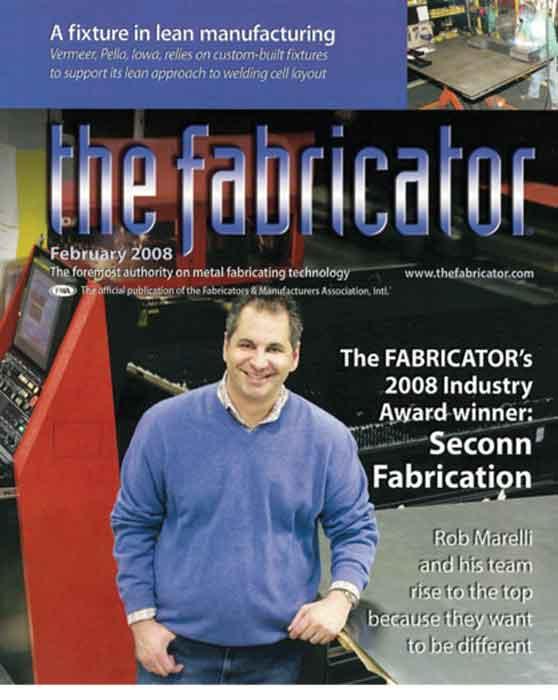
In 2008 The FABRICATOR gave its first Industry Award to Seconn Fabrication, Waterford, Conn. The publication provided an update on the company in its January 2020 issue (“Refocus and renew,” p. 68).
The company started with a Mazak Optonics Super Turbo X510 Hi-PRO for 2-axis cutting. The machine was equipped with an automated load/unload cell for unattended operation. That proved a success and the shop ultimately added two more lasers, one of which was a SpaceGear, a multiaxis machine that gave it the capability to laser-cut features such as holes at various angles, bevels, and saddles.
Pleased with this new capability, the company decided it wanted to chase after high-volume work centered around tube fabrication. That led Target to purchase a FabriGear 4-kW tube cutting laser with bundle handler. It was the first company in the U.S. to have this type of machine.
Even then company officials knew they had to be able to produce quality parts cost-effectively and make delivery commitments. The world was growing smaller by the day.
“Right now we are unable to compete with China on a piece-per-piece basis,” said Gary Reiter, Target’s owner. “We have to create value for our customers through delivery, support, and service … The days of simply providing a part are waning.”
July 2007
Best Feature Title Ever?
Kirsan Engineering Inc., Kenosha, Wis., created a new saw loader that relied on a lift truck, which kept its employees out of harm’s way. The FABRICATOR was there to share the story. The headline? “Better safe than saw awry.”
October 2007
Know Why You Are Automating
“Successful automation isn’t automatic” covered the journey Fox Valley Metal-Tech, Green Bay, Wis., took to install a Mitsubishi River automated material processing system. Probably the best piece of advice to come out of the article was that the fabricator had a distinct reason to move toward material handling automation. It wasn’t automating for automation’s sake.
Fox Valley made the purchase of its first automated material handling system seven years earlier. That original investment in an MSCI automation system was made because the fabricator was losing money related to scrap generated by bad material transfer practices. A study of Fox Valley’s operation revealed that moving certain materials with a lift truck, particularly stainless steel and aluminum, was causing scratches that resulted in rejected parts.
That system was soon upgraded to an MSCIII system with the River Navigation, which allowed the fabricator to leave behind the world of moving sheets and plate from wood pallets to metal skids. The automated system allowed the shop to load sheet metal directly into a storage tower, which then fed the laser cutting machines. The MSCIII also picked up the parts with suction and deposited them directly into laser loading bays, helping to minimize scratching.
March 2008
Virtually Welding
The FABRICATOR provided its first in-depth coverage of welding simulation tools, which now are much more prevalent in educational institutions and private companies. Back then, the technology was just being commercialized, so it was still being fine-tuned.
As one virtual welding technology user said at the time, “We assumed the proper way to weld was like a golf swing,” meaning that his company thought that everyone was taught to weld the same way everywhere. But that’s not necessarily the case with welding. Different applications have different needs.
Even though the tool might cost several times more than an average welding power source, educational institutions did see its potential. They didn’t need to worry about constantly acquiring metal coupons for welding or dealing with scrap. Students who had never welded before might not be as intimidated when compared to handling a welding gun right off the bat. Liability concerns were reduced with this virtual technology.
Of course, the sources for the story indicated that this was no substitute for real-world welding experience. They were right there, but they also knew that the technology could be used to test job applicants or to teach basic movements before moving to a live arc. In short, virtual welding has indeed made a positive impact on welding training.
April 2008
The Bold in Arches
It may not mean much to the rest of the world, but when McDonald’s tore down its restaurant in the River North neighborhood of downtown Chicago in the early 2000s, it was kind of a big deal. Thousands of Chicagoans knew the restaurant as the “Rock ‘n’ Roll McDonald’s” because of its musical theme. The new restaurant had to be pretty special if local citizenry were to ever forgive the chain for removing a beloved fast-food joint.
The new restaurant was supposed to be a remembrance of its past with a nod to the future. Its most eye-catching feature was a pair of parabolic arches that stand 60 ft. high. The arches were constructed from 20- by 12-in. tubes by Chicago Metal Rolled Products, and the story was covered in “Curving out a niche.”
“We had never rolled these tubes into a parabola before,” Chicago Metal Rolled Products’ George Wendt said. “We found that we could do these pretty well; that there was minimal distortion; that we could do them fast. It was a little bit of a risky project, but something that gave us more confidence that we could go on and tackle other difficult projects and compete with anyone on how quickly we can do this.”
May 2008
Fabricating: The Real Deal
Senior Editor Tim Heston has his byline all over this magazine every month, but if you don’t read his Biz Talk column, you are doing yourself a disfavor. He understands the metal fabricating business and has come to appreciate its place in the overall U.S. economy.
One of his best columns (“Real companies, real products, real customer service”) addressed his admiration for the tangible nature of metal fabricating, with its parts and components being made for paying customers, as opposed to the hard-to-understand world of mortgage-backed securities, which ultimately brought down the economy earlier in the decade. In short, building an investment business off bundled loans made to people who only years previously would have never qualified for a bank loan was a good idea?
Heston quoted Michael Greenberger, who served on the U.S. Commodity Futures Trading Commission in the late 1990s: “Should we have an economy based on whether people make good or bad bets, or should we have an economy where people build companies, create manufacturing interests, and make it more productive? We are rewarding people for sitting at their computers and punching in bets. That’s not the way this economy is going to be built.
“India and China, with their focus on science and industry, and building real businesses, are going to eat our lunch unless the American public wakes up and puts an end to an economy that praises and makes heroes out of speculators.”
November 2008
A Fresh Approach to Rocket Fabrication
If you have been paying attention recently, you know that SpaceX’s first human-rated spaceship just completed a 64-day test flight to the International Space Station. The company has long made it known that it was going to come at space travel from a fresh angle, but readers of The FABRICATOR knew that already.
In 2008 the publication profiled SpaceX. The opening paragraph gave you an idea of just how different this organization was going to be when compared to NASA: “Aerospace executive Chris Thompson, who reports directly to his company’s CEO [Elon Musk], knows all about the retractable-pin friction stir welding sysem on the floor. He directly oversees it and has operated it himself.”
Work back then was focused on the Falcon 9, which helped to pave the way for the Dragon. Today work is focused on getting man back to the moon and perhaps Mars.
January 2009
Energy-efficient Bending
The FABRICATOR revisited electric and hybrid press brake technology and learned that it was beginning to garner more interest from metal fabricators, who were becoming more aware of the reduced costs of running the devices. Of course, the electric brakes didn’t need any hydraulic oil, but even the electric-hydraulic brakes required only a third to half of the oil of conventional hydraulic brakes.
Fabricators increasingly are adopting these efficient press brakes as their main bending workhorses. Considering that these units hardly draw any power when sitting idle, you can understand why that makes the shop owner and company’s accountant smile a bit more than when they were running all hydraulically powered machines.
February
2009 Rewarding Everyone in the Shop
Tim Heston profiled E&E Metal Fab in “Sustaining success in a downturn” and found a company that was on track to boost its sales revenue in the midst of an economic downturn. The Lebanon, Pa.-based shop was on track to hit $4.5 million in 2008, three times more than it made in its first year in business, which started with the company’s founding in November 2003.
The company’s founder, Willie Erb, said he had worked in companies where infighting and politics were common. He wanted his shop to be different.
“We all experienced the sad disappointments, the lies, and now we experience truth, fun, and excitement,” he said. “Nothing was for us. It was all for them. We wanted something that was for us, from the entry-level person to the president of the company. It’s all for us.”
Profit-sharing reinforced this approach. It also should be noted that Erb said he never really had any trouble finding new employees. They found his company.
September 2009
The Digital Revolution Hits Structural Fab
Structural steel fabrication requires a group effort to be successful. You’ve got architects, general contractors, government officials, the structural steel fab shop, and erectors, just to name a few. Imagine trying to keep all of these parties on the same page without the use of digital tools. Well, phone calls and paper documents used to be the main tools in this communication loop, and that still remains the case for some older companies. But not for A. Zahner Co., Kansas City, Mo.
In a profile, the company revealed itself to be an aggressive adopter of new technologies, from 3D modeling to a new ERP system. Company management viewed it as a way to eliminate waste from the supply chain.
Verbiage on the company website summed it up nicely: “Over the last decade, the design, engineering, and construction industries have been working to integrate digital technology into the process of construction. Like a growing leak in the dike of ingrained conventions, the integration of digital technology is dissolving the barriers that slow down the building process. Companies that do not embrace this technology will be overwhelmed by the shift that is occurring.”
December 2009
Tiny Living
Shows about tiny houses could be found all over cable television only a year ago. The FABRICATOR was on the trend more than a decade ago.
Contributing Editor Eric Lundin had a Back Page feature on CI Weld ‘N’ Fab, Vancouver, B.C., Canada, which was fabricating homes out of shipping containers. How small were the homes? Just over 300 sq. ft.
That’s enough on that subject.
About the Author

Dan Davis
2135 Point Blvd.
Elgin, IL 60123
815-227-8281
Dan Davis is editor-in-chief of The Fabricator, the industry's most widely circulated metal fabricating magazine, and its sister publications, The Tube & Pipe Journal and The Welder. He has been with the publications since April 2002.
subscribe now

The Fabricator is North America's leading magazine for the metal forming and fabricating industry. The magazine delivers the news, technical articles, and case histories that enable fabricators to do their jobs more efficiently. The Fabricator has served the industry since 1970.
start your free subscription- Stay connected from anywhere

Easily access valuable industry resources now with full access to the digital edition of The Fabricator.

Easily access valuable industry resources now with full access to the digital edition of The Welder.

Easily access valuable industry resources now with full access to the digital edition of The Tube and Pipe Journal.
- Podcasting
- Podcast:
- The Fabricator Podcast
- Published:
- 04/16/2024
- Running Time:
- 63:29
In this episode of The Fabricator Podcast, Caleb Chamberlain, co-founder and CEO of OSH Cut, discusses his company’s...
- Trending Articles
How to set a press brake backgauge manually

Capturing, recording equipment inspection data for FMEA

Tips for creating sheet metal tubes with perforations

Are two heads better than one in fiber laser cutting?

Hypertherm Associates implements Rapyuta Robotics AMRs in warehouse

- Industry Events
16th Annual Safety Conference
- April 30 - May 1, 2024
- Elgin,
Pipe and Tube Conference
- May 21 - 22, 2024
- Omaha, NE
World-Class Roll Forming Workshop
- June 5 - 6, 2024
- Louisville, KY
Advanced Laser Application Workshop
- June 25 - 27, 2024
- Novi, MI
























